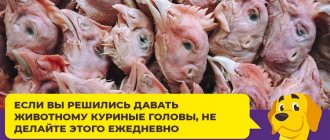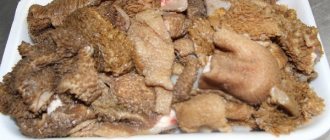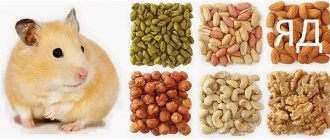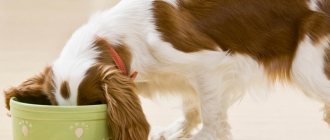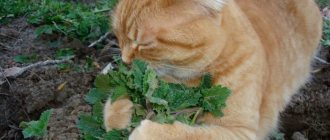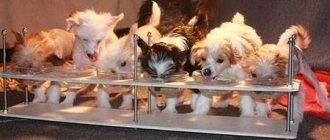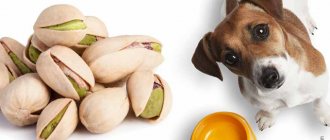Which one is possible?
What dog cereals can, and most importantly, should be given to kids? Buckwheat, oatmeal and rice cereals are most suitable for puppies ; they can also be mixed and cooked together.
When considering the question of what cereals can be fed to dogs, do not forget that they all contain phytic acid , which binds calcium, magnesium, phosphorus, zinc and other trace elements, which makes their absorption in the intestines impossible.
However, there is a simple solution: phytic acid is partially destroyed during cooking and soaking. If you soak the cereal overnight and boil it for about twenty minutes, there won’t be much harm .
IMPORTANT !
In any case, it is necessary to carefully monitor the reaction of the pet’s body: some dogs experience allergic reactions.
Corn grits in dog food
Corn starch is often added to inexpensive feeds, but it is this that acts as the main provoking factor in the development of diabetes and obesity in pets.
The glycemic value of this component is high and indicates how sharply the dog’s blood glucose can increase after consuming the food.
When the concentration of sugar in the blood is high, the level of the hormone insulin also increases. The greater the deviation from the norm, the higher the risk of problems associated with diabetes and obesity.
How often?
- 2-3 months: fed six times a day: every three hours, starting at about seven in the morning and ending at nine to ten in the evening.
- 2-4 months: four to five times a day, increasing the interval between feedings.
- 4-6 months: three to four times a day, every five to six hours.
- 6-10 months: three times a day, every six to seven hours.
- older: twice a day, morning and evening, like adult dogs.
At 1-2 months, meat or fish is given once a day; twice - porridge with water, meat or vegetable broth, with the addition of vegetables and meat; once - milk, cottage cheese or kefir; the remaining two times you can give dairy products or oatmeal cooked in milk.
The time of one feeding is about 15-20 minutes. If there is any food left in the bowl after this, it should be removed.
IMPORTANT ! Before giving your puppy physical activity, you must wait 1-2 hours after eating. Excessive activity on a full stomach can seriously harm your pet's health.
It is also useful to install a stand for bowls at the level of the puppy's chest: you can make it yourself or buy it. The tripod stand will last a long time because it allows you to adjust the height as the animal grows.
Is it possible
Both puppies and adult dogs are strictly advised not to eat certain grains, as they can cause indigestion, metabolic disorders, allergic reactions and other serious health problems.
Dairy
Compatibility test: can a dog have milk and fermented milk products? Artificial feeding of a puppy: substitute
Hercules
Let's turn to oatmeal. Oatmeal is high in calories, it has more fiber, protein, fat, calcium and phosphorus than rice and buckwheat. However, it is worth noting that it is only suitable for active dogs: castrated and sterilized animals are not allowed to give oatmeal . But for those who actively run and jump, it is possible.
In some dogs, oatmeal causes intestinal upset - this is individual and, of course, it is better to exclude it from the diet. But for dogs suffering from gastritis and stomach ulcers, oatmeal broth or jelly is very useful. Weakened, sick animals, pets on a diet, and growing puppies will only benefit from oatmeal.
“I’ll cook everything for myself”
Can a dog eat oatmeal? It is possible if this dog eats oatmeal all its life, does not get fat from it, and its intestines cope.
Is it necessary to specifically switch the dog to oatmeal porridge? No.
In any case, oatmeal, like any other cereal, requires correction and can be given within certain limits, without replacing meat with it.
Manna
Many people are interested in the question: is it possible to feed semolina porridge to babies? In fact, semolina is used mainly for those puppies (from newborns to a maximum of 3 months) who need to gain weight.
It is very high in calories, but it contains almost no vitamins and microelements (only a little potassium and iron), a small dose of fiber (only 0.2%), but a large amount of B vitamins.
Semolina is also allowed on the recommendation of a veterinarian in the treatment of gastrointestinal diseases. It is sometimes allowed to give it to older puppies, but in moderation.
Millet
Millet is too difficult to digest and can even cause intestinal volvulus. In addition, millet can cause severe allergies! Even mixing with other cereals is undesirable.
Pearl barley
Pearl barley , which is an allergen, is also contraindicated And despite the fact that barley contains a lot of vitamins, the body of a dog, especially a puppy, cannot even absorb a third of them. In addition, eating pearl barley porridge leads to constipation and even allergies in dogs.
Legumes are undesirable - they often cause bloating. It is strictly forbidden to give porridge made from corn grits , it is also practically not digestible in a dog’s stomach. Corn may be fresh or cooked on the cob.
Wheat and barley porridge can only be consumed by adult and healthy dogs leading an active lifestyle..
Pearl barley for puppies and pregnant dogs
We answered positively the question of whether it is possible to feed a dog pearl barley, but in addition to the general rules, you need to remember a few more restrictions. Cereals are not recommended for puppies and older adults. This is due to the fact that their digestive system is weak and will not digest the product. In the worst case, the pet may develop health problems; in the best, it will be left without nutrients. And they are especially important at an early and advanced age.
On the other hand, there is an opinion that large breed puppies older than six months can cook porridge in milk and give it in small portions. Try this complementary food and watch your pet’s reaction. The first day they feed a few grams of the dish, gradually increasing the serving size. It is better not to give croup to dogs of small breeds, especially for Chihuahuas, Yorkshire terriers and toy terriers, they have sensitive digestion. German Shepherds have a similar feature. Avoid the product if your four-legged friend has gastrointestinal pathologies.
It is also important for pregnant females to eat a balanced diet so that the body receives enough vitamins and minerals. Pearl barley will not provide such a diet, therefore, during the period of bearing and feeding puppies, it is better to replace the barley with rolled oats, rice, and buckwheat.
Depending on the breed
German Shepherd
Porridge should make up 25-35% of the total diet. You can give buckwheat, rice and oatmeal porridge. They are usually supplemented with meat and vegetables.
Mom-Dad, thank you for the delicious porridge!
Husky
Steam oatmeal flakes with boiling water and let steep for 10 minutes. It is not recommended to give oatmeal often, because... it weakens, but can easily be replaced with rice or buckwheat. Add raw yolk, a little raw minced meat and cottage cheese - voila, breakfast is ready!
Malamute and Husky: 12 differences with clear photos
Labrador
The following recipe is useful for Labrador puppies: steam finely ground oatmeal with milk, add 1 tsp. fish oil and 2 glucose tablets. You can also cook buckwheat with meat in vegetable broth.
“Can I have some more porridge?”
Devoted friends Golden Retriever and Labrador: 5 differences
York
For Yorkies (as well as Shitzus, toy terriers and pugs), oatmeal and semolina are unacceptable, because... These dogs are prone to obesity. To prepare a delicious porridge for your Yorkie, take a small carrot, a little cauliflower, and 2 tablespoons of buckwheat. Cook everything until tender (about 30 minutes), then mix the resulting dish with a blender, add a little unrefined vegetable oil, boiled beef or chicken and serve the porridge to the dog. There should be no salt and pepper!
Calculate a serving of cooked porridge as follows: 500 grams. pet's weight - 1 tablespoon of porridge.
The benefits of cereals
Cereals have different effects on the animal’s body:
- Rice is a source of calcium, copper, zinc, iron, as well as vitamins B and E. Cereals quickly remove toxins from the body, so it is useful for dogs to consume. survivors of poisoning. The astringent properties of rice make it possible to cope with diarrhea and eliminate the inflammatory process in the gastrointestinal tract.
- Oats are rich in amino acids, vegetable proteins, vitamins A, PP, E, B, as well as calcium, sodium, magnesium and potassium. Helps the animal recover from starvation or illness. But in some pets, oatmeal can cause allergies and digestive upset.
- Peas. Dogs do not have the enzymes responsible for the complete breakdown of legumes. Therefore, when consuming the product, a large amount of gases is formed, causing discomfort to the animal.
- Millet. This cereal is difficult for the animal to digest and provokes severe allergies.
- Corn. In the dog's gastrointestinal tract, corn porridge collects in lumps, which threatens intestinal volvulus.
- Semolina is a source of “empty” carbohydrates. Can only be used to feed underweight puppies.
- Perlovka . Polished barley contains many useful substances, but the dog’s body cannot absorb them. In addition, eating grains causes constipation and allergies.
- Wheat . Despite the high nutritional value of wheat, it should be added to your pet's diet with caution. Cereals are not completely digested and can lead to obesity and increased blood sugar. Therefore, a small amount of wheat porridge with meat and vegetables can only be given to healthy dogs of large and small breeds.
- Barley grits. The porridge turns out nourishing, rich in silicon and fluorine. It is not absorbed as well as buckwheat and rice, so it is not suitable for daily use.
You should not select porridges for your dog’s diet based on their benefits to humans.
Some modern nutrition systems, for example BARF, advise completely eliminating cereals from the dog’s diet. This theory is based on the fact that in nature predators feed exclusively on meat.
How to cook: recipes
Ready-made porridge with broth can be stored in the refrigerator for up to 48 hours. You can also cook cereals, vegetables and meat separately and mix them before giving it to the puppy. In this case, the porridge is cooked in clean water without salt or additives, after cooking it is cooled, transferred to a clean container and stored in the refrigerator.
Any cereal, except oatmeal, should be well-cooked, but not paste-like, but crumbly . After cooking, leave the porridge tightly closed and let it brew for half an hour.
Oatmeal is not boiled, but steamed in boiling water. Be sure to wash the grains with running water before cooking.
Boiled fish is cleaned of bones and chopped; the meat is better digested when cut into cubes. Vegetables are also cut into cubes or grated.
Raw vegetables and meat are placed in the porridge 3-5 minutes before readiness; offal is cooked in advance in a separate broth, which is then not used. Ratio of cereal and water: 1 to 2 or 1 to 3.
IMPORTANT ! If minced meat is used instead of meat to prepare the broth, it should first be filled with water, stirred and left for a few minutes. Then remove the floating fragments of fat and skin.
Recipes for how to cook porridge for your pet:
Buckwheat in broth
- Place the meat in boiling water and cook over low heat until the meat is completely cooked, skimming off the foam regularly. Cooking time depends on the quality of water and meat and can take from 40 minutes to 2 hours. Remove the meat.
- Pre-soak the buckwheat in water for 20–30 minutes, drain off the floating husks, and place the grains in a sieve. Add buckwheat to the boiling broth in a ratio of 1:3, after boiling, cook for 15-20 minutes, stirring.
- 3-5 minutes before the cereal is ready, diced raw meat or vegetables.
- Bring to readiness, mix thoroughly, cover and leave for 20-30 minutes. You can cover the pan with a towel.
- Before eating, add a little butter or vegetable oil or fish oil to the prepared warm porridge.
On the water
- Pour the washed cereal with water in a ratio of 1:2 or so that the water level is two fingers higher than the level of the cereal, cover the pan with a lid and cook until the liquid has completely evaporated, 15–20 minutes after boiling.
- Cover the pan with a towel and leave to steep for 20–30 minutes. If you use unpolished rice to prepare porridge, you should cook it for 35-40 minutes.
- If the cereal is polished, you can add a teaspoon of sunflower or olive oil to the water before boiling.
Rice with milk
Pour the washed cereal with milk in a ratio of 1:2, add a teaspoon of vegetable oil. After boiling, cover tightly with a lid and cook for 20-30 minutes. Turn off the heat and leave on the hot surface for another 5-10 minutes, then open the lid and stir.
IMPORTANT ! The food must be warm; you cannot feed the puppy hot or cold!
Other types of products
- Popcorn is absolutely useless food for dogs; a small amount of it will not cause significant harm, but can cause digestive upset.
- Corn flakes are dangerous, because the corn mass, before being fried and becoming flakes, is abundantly fertilized with various chemical additives that are completely undesirable for any animal.
- corn sticks also contain a lot of sugar; the dog’s body is not equipped to digest it, and therefore a strong allergic reaction is possible.
Possible additives
Milk
Dairy products are the most important nutritional element for puppies, especially under three and a half months of age. You can cook cereals in milk, or you can cook them in water, low-fat meat or vegetable broth.
Milk, kefir, yogurt, cottage cheese or yogurt should be added to ready-made porridge with water or milk or fed separately. Also add pieces of vegetables and fruits, berries, nuts to the porridge, and add a teaspoon of honey.
Meat
It is possible and healthy to feed your puppy veal, beef, veal, lean lamb, rabbit and turkey meat, horse meat , cook and mix meat by-products such as heart, kidneys, lungs, and liver with porridge and vegetables.
Chicken should be added to the diet carefully and carefully monitor how your pet’s stomach reacts to it.
The meat must be frozen for two or three days and defrosted to room temperature before feeding.
Instead, you can also pour boiling water over it, put it in the porridge a few minutes before it’s ready and boil it a little, leaving it half-baked. For broth, it is best to use bones rather than meat, which are then removed. Meat by-products can be processed in the same way as meat, but it is preferable to boil them.
IMPORTANT ! Poultry meat must be separated from the bones and added to the porridge; giving bones is strictly prohibited.
Fish
Sea fish can be fed raw or in the same way as meat, but river fish must be processed to eliminate the risk of infection with parasites. First, you must remove all the bones from the fish or boil and grind it along with them.
Vegetables
Vegetables in porridge are placed finely chopped, raw, boiled, steamed, sometimes lightly fried, either one type or several at once. These can be beets, white and cauliflower cabbage, broccoli, bell peppers, cucumbers, zucchini, carrots, as well as greens in moderate quantities: lettuce, dill, sorrel, parsley, beet tops, cereal sprouts, etc.
IMPORTANT ! Vegetables and fruits should be washed, vegetables should be peeled. Nettle must first be doused with boiling water.
Fats
1-2 times a week you should add a hard-boiled chicken egg or a raw yolk without white.
Starting with a few drops and gradually increasing to a teaspoon, you can add vegetable oil, and from two months of age - fish oil. Also add crushed chalk or eggshells to the porridge (it should be crushed especially carefully to prevent the ingress of sharp particles), and a little butter.
IMPORTANT ! It is forbidden to give puppies fatty meat, pork, minced meat, and smoked meats. You should also not add sugar or sweets, since dogs cannot digest glucose and can cause fermentation in the intestines. Hot foods and spices can irritate the stomach, and sausages contain many harmful substances.
Pasta is allowed, infrequently and in moderation.
You should teach your puppy to eat a variety of foods. If the puppy has a predilection for something specific, this should be taken into account, and for the rejected food, take a break for a week or two. Sometimes you can add salt, but not a lot and not often: salt itself is found in all foods.
Each new product should be introduced into the diet gradually and monitor the intestinal reaction and possible allergic skin reaction. If necessary, a break is taken.
IMPORTANT! Dry food should not be mixed with porridge or other natural products.
Tips for choosing
- First of all, check whether your dog eats porridge in principle? Prepare several types of porridge and serve with broth throughout the day. If you find that the dog only drinks the broth and leaves the porridge, then there is little point in forcing an unloved product into it.
- If you have determined which variety your pet likes, give it in small quantities so that it can be canceled without serious consequences in case of poisoning or allergies.
- When the variety is selected, determine the amount of cereal in the diet, depending on the pet’s activity from 5% (inactive) to 40% (very active).
Additional Ingredients
They definitely won’t hurt, because dogs also sense taste and smell and will not eat tasteless, bland food.
What you can add:
- Green herbs (dill, parsley, basil) - they will enrich the porridge with fiber;
- Potatoes, tomatoes, tomato paste (in small quantities) - starch contained in the composition also regulates digestion processes and is food for bacteria in the intestines.;
- Any types of cabbage (sea cabbage, white, cauliflower) - it is easily digestible and will add a pleasant aroma to the porridge;
- Meat supplements with which the dog will receive comprehensive nutrition with every meal;
- A small amount of cottage cheese, which will serve as a lactose-free alternative to milk;
- Egg yolk is a source of healthy animal fats.
What not to add:
- Seasonings (especially hot ones) - they only irritate the sensitive receptors on the dog’s tongue, as well as the gastric mucosa;
- A large amount of oil and fat will disrupt the natural metabolism and may disrupt the digestion process;
- Sausage, frankfurters and other products of unknown origin;
- Margarine, which causes general harm not only to dogs, but also to humans;
- Mayonnaise, ketchup and other harmful dressings.
The ratio of cereals and additives. How much per day to give?
The portion is calculated according to the age and weight of the puppy, and then it is monitored whether he is full or not. If the pet willingly ate everything and licked the bowl, next time increase the amount of food given. Some animals do not leave anything, even when they are full, you should not allow them to overeat.
The total amount of food per day is 5% of the puppy’s weight; at the age of up to 4 months, another 100 g is added for 1 month of life.
- 1-2 months: cereals and vegetables should make up 10% of the food volume.
- 2-3 months: 15-25% cereals and vegetables, 35-50% meat and 40-50% dairy products.
- from 4 months: meat consumption increases, and other products decreases: the diet consists of 10-15% of cereals and vegetables, 25-50% of dairy products and 50-70% of meat.
Increasing the ratio of one at the expense of the other is inappropriate, including for the purpose of saving.
The amount of meat is calculated based on the requirement of 20-30 g per day per kg of puppy weight. Twice a week, instead of meat, fish should be given, 40-60 g per kg of weight.
Per 1 kg of weight:
- 1.5 g fiber
- 9 g protein
- 13.8 g carbohydrates
- 2.64 g fatty acids.
A third of the daily meat ration is added to the porridge; the rest should be fed raw.
The cooking ratio is:
- 30% cereals
- 40% meat, meat by-products or fish
- 30% vegetables and feed additives.
If it so happens that a feeding was missed, during the next feeding the usual portion is given, without additives. The same applies to the temporary replacement of some products with others. If at some time your pet is given meat porridge instead of milk, there is no need to then try to make up for the missed meal with additional portions or “replace it the other way around”: you should just continue to feed it as before.
IMPORTANT ! The puppy must have fresh water at any time of the day.
Varieties
Raw on the cob
Dogs love to chew on corn on the cob, but once in the stomach, raw corn kernels swell, significantly increasing in size.
Undigested particles descend into the lower parts of the digestive tract and can cause intestinal blockage, which is, at best, constipation, and at worst, volvulus and painful death .
Also, a pet can easily choke on a cob, so it’s better not to let your pet near them at all.
Boiled
Just like baked corn, raw corn is safer, but since it is completely indigestible , there is no point in giving it to your dog.
Canned
Corn is usually canned with vinegar, spices, salt and sugar and is therefore a good idea to avoid in your dog's diet.
Summing up
- Porridge is an important part of a puppy's diet.
- Buckwheat, rice and oatmeal cereals are most suitable for puppies.
- Bowls with food and water should be placed at chest level so that the puppy does not have to bend over while eating and drinking.
- High physical activity should be developed no earlier than after 1-2 hours.
- The puppy’s diet should be varied and complete; one food cannot be replaced with another to the detriment of nutritional value and vitamins.
- Food should always be warm and fresh.
- It is important to know which foods can be consumed by puppies, which by adult dogs, and which should not be included in the diet at all.
- It is necessary to ensure that the puppy does not remain hungry or overeat.
- Your puppy should always have access to clean, fresh water.
So, after reading this article, you can now determine what and how to feed your little four-legged friend so that he grows up healthy and cheerful. And surely you have your own personal experience and opinion that you would like to share, your stories and photos of your pets? We are waiting for your comments.
What to do if your dog has indigestion?
If you notice one or more signs of indigestion, give your dog first aid. Her discomfort will be eased by:
- Warm soapy enema.
- Taking absorbents (activated carbon, Enterosgel).
- Massage the abdomen (in a clockwise circular motion), if the dog allows, you can slightly press the hind legs to the stomach.
These manipulations will help release gases. The feeling of fullness will become less, the pain will go away. Physical activity will speed up the process of getting rid of flatulence.
If the situation worsens, when the bloating becomes severe and does not go away, you must contact the clinic. The situation requires urgent help, since delay can lead to serious consequences, including death (gastric rupture, autointoxication). The veterinarian will puncture the stomach and release the gases.
